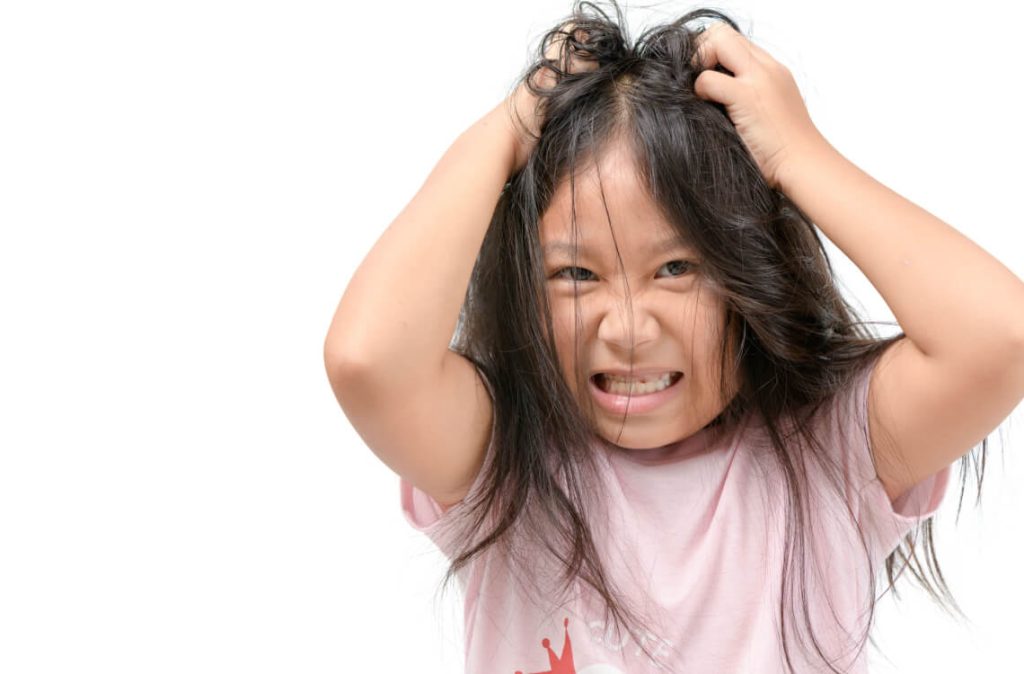Imagine tiny creatures living in your scalp, feeding on your blood while you sleep.
That’s right, head lice – every parent’s worst nightmare. What happens when your family is facing an infestation?
We sat down with Nazatul Amira Hamzah from Primabumi Sdn Bhd to learn more about what parents can do if their child comes home from school with a headful of lice.
Nazatul is a qualified pharmacist with 10 years of experience in pharmacy practice involving both hospital and community settings.
She currently holds the position of Pharmacist and Key Account Manager at a renowned pharmaceutical company in Kuala Lumpur.
A pharmacist gives life-saving advice on how to deal with these invisible blood-sucking parasites.
Question 1: My child recently complained of a very itchy scalp. When I check their hair and scalp closely, I noticed some tiny white eggs. I couldn’t remove them easily by brushing. What are they?
These white eggs belong to head lice.
Head lice are small, wingless insects that crawl and lay eggs (known as ‘nits’) on the hair shafts.
They feed themselves by sucking on the blood of the human scalp.
Although anyone can get a head lice infestation, it’s more common among school-aged children.
Question 2: How did my child get head lice?
This happens when the head lice or the nits from an infected person crawl on your child’s head by direct contact.
Infestation can also happen by sharing items like combs, towels, and hats.
Pease take note that poor hygiene or unclean environment isn’t the cause for head lice transmission.
Question 3: How do I know if my child might have head lice?
The following are the most common symptoms of head lice:
- intense itchiness, particularly on the back of the head and neck and near the ears
- tingling sensation on the scalp (feeling like something is moving in one’s hair)
- irritation on the scalp due to scratching
- difficulty sleeping
You can check for lice by carefully running a fine-toothed comb or specialised head lice comb through your child’s hair to find any nits or head lice.
Adult lice are hard to spot because they move around quickly.
Question 4: Can head lice cause skin infections?
No, head lice do not carry infectious diseases.
However, too much scratching of the scalp may break the skin and cause infection.
Head lice must be eradicated quickly so they don’t spread to anyone else in your family.
Question 5: How do I treat my child’s head lice?
You can clear head lice by using over-the-counter medicated shampoos or lotions.
Question 6: How long does it take to clear my child’s head lice?
This depends on how many head lice and nits are present in your child’s hair.
It may take up to 3 weeks to completely get rid of them with effective treatment.
Often, more than one treatment is necessary.
Question 7: I don’t feel comfortable using those medicated applications on my child. Is there any other way to get rid of head lice?
You can use a fine-toothed lice comb to remove lice and nits from your child’s hair.
You can apply something like olive oil before doing this so the lice and nits stick better to the comb.
Starting at the scalp, comb through the hair to the ends.
Repeat every 2 to 3 days until your child’s hair is completely clear of signs of lice or nits.
Question 8: Am I or other family members at risk of getting head lice?
As head lice can easily spread from person to person, you need to make sure everyone in your household is checked for head lice.
They will have to undergo treatment if they are found to have head lice, too.
Here are some helpful tips to practice to help protect others in your household from getting head lice:
- avoid sharing personal items
- use hot water to wash clothing, bedding, and textiles
- seal items that are not suitable for washing or drying such as hats and plush animals in a plastic bag for two weeks
- soak combs and hair accessories in hot water for 10 minutes after use
- vacuum floors and upholstered furniture
Question 9: Should my child stay at home while undergoing treatment for head lice?
Your child can still attend school or nursery.
However, you need to inform the teachers or caregivers of your child’s issue.
Therefore, necessary precautions can be taken and other kids can be checked for head lice.
Question 10: How do I prevent my child from getting head lice in the future?
The most effective way to prevent head lice is to avoid physical contact with an infected person.
Teach your child to avoid head-to-head contact and share anything that they put on their head with others during playtime.
Source: Nazatul Amira Hamzah, Pharmacist at Primabumi Sdn Bhd
Disclaimer: The information provided in this article is for informational purposes only and should not be considered as medical advice from Motherhood. For any health-related concerns, it is advisable to consult with a qualified healthcare professional or medical practitioner.
For more insightful stories and fun recipes, stay tuned to Motherhood Story!
